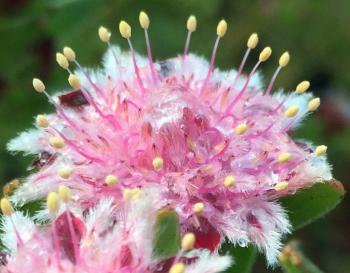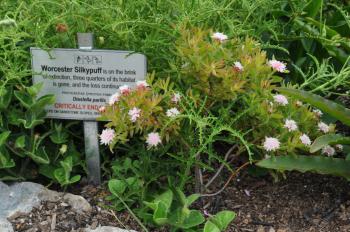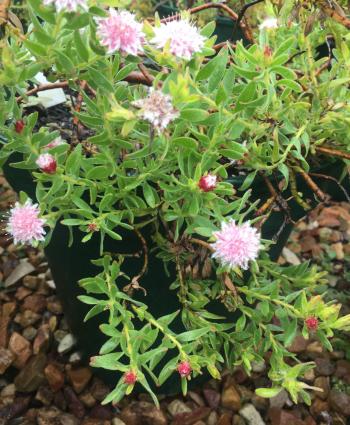Diastella parilis
Diastella parilis Salisb. ex Knight
Family: Proteaceae
Common names: Worcester silkypuff
Introduction
A rounded, fynbos shrublet, with pleasant pink flowers for more than six months, that is suitable for cultivation in containers.

Description
Description
Diastella parilis is a small, evergreen shrublet, that grows about 0.5–0.7 m high. It grows from a single stem that will branch to produce many stems that grow upwards and outwards, giving it a rounded shape. The lower stems often grow flat along the ground, or hang over the sides of the container when cultivated. The old stem becomes brown and hairless, whereas the new stems are soft and hairy. It produces soft hairy leaves 10–30 mm long and 2–5 mm wide. The leaves are oblong to elliptic, obtuse with an entire or trifid-callused apex, and 1–3 pink glandular teeth.

Diastella parilis has small, terminal, sessile flowerheads, 15–20 mm across, that resemble tiny powder-puffs. They are produced from mid-winter to mid-summer (July to January), often in clusters of 2–6. The flowers have pink perianth tubes, 2 mm long, covered with white hairs and pink to red styles of 10 mm long. The pink perianths and styles turn white with age. The involucral bracts are ovate and turn brown and become papery with age. The involucral bracts have long hairs on the margin and very short hairs on the upper and lower surfaces. It produces an egg-shaped, nut-like seed of 4–6 mm long, greyish or white, which is released 1–2 months after flowering.
Diastella parillis flowerheads are similar to those of D. divaricata, but differ by their larger size and unequal perianth lobes.
Conservation Status
Status
According to the Red List of South African Plants, checked on 27 January 2017, Diastella parilis is assessed Critically Endangered (CR). It is on the brink of extinction in the wild because more than three quarters of its range has been lost or damaged due to the expansion of vineyards, drainage of seasonally damp areas being been altered as a result of agricultural expansion, inappropriate fire management and invasive alien plants. Furthermore, this loss of habitat is continuing.

Distribution and habitat
Distribution description
Diastella parilis is endemic to the Western Cape province of South Africa, and occurs in the Breede River Valley, from the Elandskloof Mountains to Slanghoek, where it grows in scattered clumps on sandstone foothills in seasonally damp areas.
Derivation of name and historical aspects
History
The name Diastella is derived from the Greek word diastellein, which means ‘to separate’. This refers to the soft, silky-haired perianth segments which are free to the base. Parilis means ‘equal’, which refers to its similarity to other species.
Diastella is one of 14 genera of the Proteaceae family and is a small genus of 7 species. Diastella is most closely related to the genus Leucospermum.
Diastella is endemic to the Cape Floristic Region, growing on acidic sandy flats and mountain slopes. All the species are dwarf shrublets and all of them are of conservation concern:
D. buekii, Franschhoek Silkypuff, is Critically Endangered.
D. divaricata subsp. divaricata, Peninsula Silkypuff, is Rare.
D. divaricata subsp. montana, Mountain Silkypuff, is Vulnerable.
D. fraterna, Palmiet Silkypuff, is Rare.
D. myrtifolia, Tulbagh Silkypuff, is Critically Endangered.
D. proteoides, Flats Silkypuff, is Critically Endangered.
D. thymelaeoides subsp. meridiana, Hangklip Silkypuff, is Vulnerable.
D. thymelaeoides subsp. thymelaeoides, Kogelberg Silkypuff, is Near Threatened.
Ecology
Ecology
Diastella parilis flowers are pollinated by insects, mostly bees. The plant produces smooth, nut-like seed which has an elaiosome. The seeds are taken by ants and stored underground in their nests. The ants consume the elaiosome but leave the seed unharmed. Usually one fruit develops in each head and drops to the ground when mature and will germinated the following autumn if not removed by ants or destroyed by rodents. The seeds drop within a period of 2 months.
Male and female parts are in the same flower (bisexual). The ‘flower’ is an inflorescence or flowerhead consisting of many small flowers clustered together inside the involucral bracts.
Plants are killed by fire, but will regenerate by seed (reseeder).

Uses
Use
Diastella parilis is an excellent and attractive plant when cultivated in containers or fynbos gardens, preferably in a rock garden. Use them as border plants or a ground cover in the fynbos garden. It is a champion when planted in plastic or terracotta containers of 20–25 cm diameter, as new shoots covered with small, puffy pink flowers lightly hang over the edges.
Growing Diastella parilis
Grow
Diastella parilis is easily propagated by cuttings and seed. Seed must be treated to prevent attack by pre-and post-emergence damping-off fungi. Treat your seed with a dusting systemic fungicide containing the active ingredient metalaxyl. The seed is best sown in late summer or early autumn. Use a well-aerated and well-drained sowing medium, smoke the seeds, using dry and green fynbos materials, or treat with Instant Smoke Plus Seed Primer. At Kirstenbosch National Botanical Garden, seed trays are placed inside a plastic tent and smoke from burning fynbos, is piped into the tent. However, most cultivation is done by cuttings, as seed collection is difficult and time consuming.
Take cuttings of semi-hardwood during autumn and spring and treat with a rooting hormone to stimulate the rooting. Dip the cuttings in the rooting hormone for at least 5 seconds. Place your cuttings in a well-drained, well-aerated rooting medium of 70% perlite and 30% fine bark or coarse sand and finely milled pine bark. Insert the cuttings in the multitrays with space between each cutting to allow air circulation and place them on heated benches of 25ºC, under intermittent mist. Regularly treat the cuttings with the fungicide to prevent fungal infections. Remove the dead leaves and wilting cuttings, until your cuttings are rooted. Move the rooted cuttings to the hardening-off house for about 2 weeks and pot the cuttings into small pots or bags, using the mixture suitable for fynbos, i.e. a well-drained, acidic medium of fine bark, coarse sand and finely milled pine bark.
Place the seedlings or cuttings under shade net in the nursery and grow on for a period of 2 to 3 years, until they are ready to be planted into the garden. Net shade reduces the direct sun, which can dry out the soil in the bags and can also prevent scorching.
Diastella parilis is a water-wise shrub when established, but it will need watering in summer for about 2 to 3 years to establish the roots. Plant the seedlings in an acidic soil, preferably between 5–7 pH levels. Diastella parilis does need pruning to keep the rounded shape.
Keep the soil moist during the hot dry season by mulching your bed about 5 mm thick. The mulch will keep the roots cool, keep moisture in the soil and reduce the growth of weeds. Chipping mulch is recommended, as they break down very slowly and also release small amount of nutrients to the plant.
Diastella parilis is resistant to Phytophthora and is not affected by other serious insect pests, however, seedlings are highly susceptible to pre- and post-emergence damping-off fungi.
References
- Adamson, R.S. & Salter, T.H (eds). 1950. Flora of the Cape Peninsula. Juta, Cape Town.
- Brown, N.A.C. & Duncan, G.D. 2006. Grow fynbos plants. Kirstenbosch Gardening Series. South African National Biodiversity Institute, Cape Town.
- Duncan, G., Brown, N. & Nurrish, L. 2013. Grow proteas. Kirstenbosch Gardening Series. South African National Biodiversity Institute, Cape Town.
- Goldblatt, P. & Manning, J. 2000. Cape Plants. A conspectus of the Cape flora of South Africa. Strelitzia 9. National Botanical Institute, Pretoria & Missouri Botanical Garden, Missouri.
- Protea Atlas Project: Meaning of Scientific Names. http://www.proteaatlas.org.za/meanings.htm accessed 20 January 2016
- Protea Atlas Project: Northern Silkypuffs – Diastellas. http://www.proteaatlas.org.za/silkypu2.htm accessed 20 January 2016
- Rebelo, A.G. et al 2004. Diastella parilis Salisb. ex Knight. National Assessment: Red List of South African Plants version 2015.1. Accessed on 2017/01/20
- Rebelo, A.G. 2001. Proteas. A field guide to the proteas of southern Africa, edn 2. Fernwood Press, Vlaeberg, Cape Town.
- Thiselton-Dyer, W.T. (ed). 1912. Flora capensis, Volume 5. Section 1. Page 653. Lovell Reeve & Co., London.
- Vogts, M. 1982. South African's Proteaceae: know them and grow them. Struik, Cape Town.
Credits
Mashudu Nndanduleni
Kirstenbosch National Botanical Garden
February 2017
Plant Attributes:
Plant Type: Shrub
SA Distribution: Western Cape
Soil type: Sandy
Flowering season: Spring, Early Summer, Winter
PH: Acid
Flower colour: Red, White, Pink
Aspect: Full Sun
Gardening skill: Average
Special Features:
Horticultural zones








Rate this article
Article well written and informative
Rate this plant
Is this an interesting plant?
Login to add your Comment
Back to topNot registered yet? Click here to register.